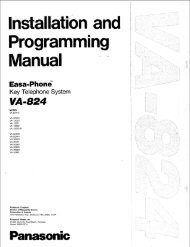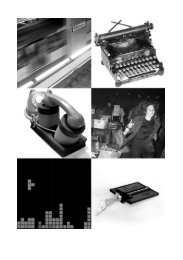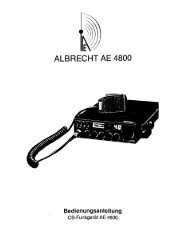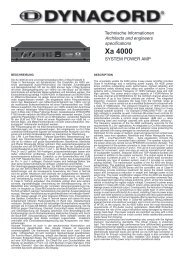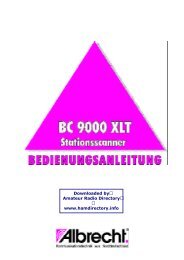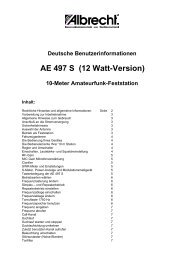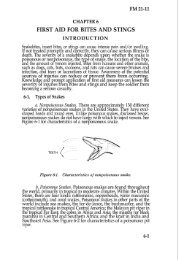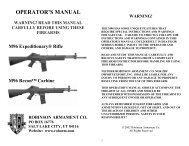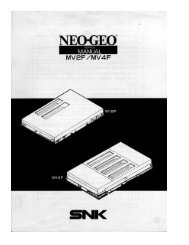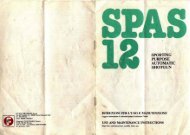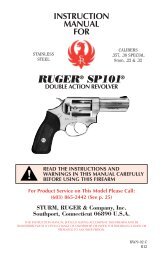Create successful ePaper yourself
Turn your PDF publications into a flip-book with our unique Google optimized e-Paper software.
To start sighting in procedure, place the rifle solidly on the some kind of bench<br />
rest or other support, and remove the bolt. Look at the target through the bore<br />
at about 25 - 30 m (27 - 33 yds) distance. Then look, without moving the rifle,<br />
through the scope, and adjust windage and elevation so, that reticle centers on<br />
target. (Same thing can be done also with a collimator, that you can use to check<br />
the alignment of the bore and the scope.)<br />
After this preliminary ocular zeroing in, it is worthwhile to proceed to final sighting<br />
in by shooting at 100 - 150 m (100 - 150 yds) distance. The best way is to<br />
shoot from a good bench rest, supporting the rifle on, for example, sandbags either<br />
from the fore-end, or from the fore-end and the butt stock. Never support<br />
your rifle from the barrel, or shoot by using a hard support, as grouping can be<br />
dramatically affected.<br />
Otherwise, follow adjustment directions given in instructions of telescopic sight<br />
that is used.<br />
MAGAZINE<br />
All <strong>SAKO</strong> Model <strong>75</strong> rifles can be supplied with detachable clip magazine or fixed<br />
magazine with hinged floorplate as option. It is also possible to make this<br />
change afterwards.<br />
AMMUNITION<br />
CAUTION! Make sure you have the correct caliber ammunition for this firearm.<br />
Use only high quality, factory manufactured ammunition. The use of<br />
reloaded, handloaded, remanufactured or other non-standard ammunition<br />
voids all warranties, and may cause severe damage to the firearm and serious<br />
injury to the shooter or others. Improperly loaded ammunition can<br />
be extremely dangerous. Always use ammunition that <strong>com</strong>plies with industry<br />
performance standards established by the Sporting Arms and Ammunition<br />
Manufacturers Institute, Inc. (SAAMI) or Commission Internationale<br />
Permanente pour l’Epreuve des Armes à Feu portatives (C.I.P.)<br />
Do not use cartridges that are dirty, wet, corroded, dented or damaged. Do not<br />
oil cartridges. Any of these things can make the ammunition dangerous, and can<br />
cause damage to the firearm or injury to the shooter.<br />
LOADING THE MAGAZINE<br />
The fixed or detachable magazine can be loaded by pressing the cartridge down<br />
into the magazine, when the bolt is in the open position. The detachable magazine<br />
can also be loaded while it is not in the rifle.<br />
CAUTION! Engage the safety before closing the bolt to reach the safest<br />
method of handling the rifle.<br />
REMOVING THE CARTRIDGES FROM THE RIFLE<br />
For safety reasons, the safety should always be in the “ON” position when removing<br />
cartridges from the rifle. The detachable clip magazine is removed by<br />
pressing the magazine release backwards. The release is located in front of the<br />
magazine and allows the magazine to drop into your hand, when depressed with<br />
the forefinger. The magazine can then be unloaded, or transported as loaded.<br />
The fixed magazine is unloaded by pressing the magazine catch located in front<br />
of the trigger guard, until the floorplate is opened and the cartridges can be removed<br />
from underneath.<br />
A cartridge can be removed from the chamber, with the safety still engaged, by<br />
pressing the bolt handle release button and opening the bolt, in which case it is<br />
easy to remove a cartridge held by the extractor.<br />
STANDARD TRIGGER MECHANISM<br />
- The trigger has no first pull and the trigger pressure is set at the factory to approx.<br />
15 Newtons (3 lbs).<br />
- Both the sear engagement and safety are set at the factory and need no adjustment<br />
of any kind. CAUTION! The sear engagement, safety and other<br />
<strong>com</strong>ponents of the action are precision mechanisms, which were properly<br />
adjusted at the factory. They should not be altered, modified or changed.<br />
Modifications to the firearm may decrease its safety and increase the risk<br />
of serious injury.<br />
- Should you wish to alter the trigger pressure, the safest way is to detach the<br />
stock first. To do this, remove the trigger guard fastening screws. Trigger pressure<br />
can also be adjusted, with a proper tool, through the magazine opening, as<br />
shown in Fig. 10.<br />
TRIGGER ADJUSTMENT (Fig. 10)<br />
- The trigger pull can be adjusted from 10 to 20 Newtons (2 to 4 lbs) with the<br />
screw 1.<br />
- Turning the screw clockwise will increase the pressure. Turning the screw<br />
counterclockwise will reduce the pressure.<br />
WARNING! FOR SAFETY REASONS DO NOT ATTEMPT TO REDUCE TRIG-<br />
GER PRESSURE BELOW 10 NEWTONS (2 LBS).<br />
SINGLE-SET TRIGGER MECHANISM<br />
For use as a normal single-stage trigger, squeeze rearwards in the normal fashion.<br />
The trigger mechanism can also be “SET” by pushing the trigger forward until<br />
it stops. The rifle can now be fired with only a light touch. WARNING! WHEN<br />
THE TRIGGER IS IN THE “SET” POSITION, THE RIFLE MUST BE HANDLED<br />
WITH EXTREME CARE, AS ANY SHOCK OR VIBRATION CAN DISCHARGE<br />
THE RIFLE.<br />
To return trigger to the “UNSET” position, the safest method is to engage<br />
“SAFETY ON” or open the bolt. If the rifle is cocked, with SAFETY ON, the trigger<br />
CANNOT be put into the “SET” position. NOTE! When the safety is in the<br />
“ON” position, it locks the trigger mechanism and the bolt. The rifle can be<br />
cocked only by pressing the bolt handle release button, located in front of<br />
the safety button, and by opening the bolt to cock the mechanism.<br />
21



